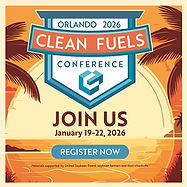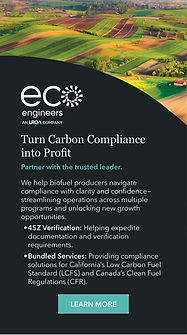Cellulosic waiver credits in the spotlight as D3 RIN prices remain high
- Corey Lavinsky
- Nov 27, 2023
- 4 min read

The cellulosic waiver credit (CWC) has traditionally served as a safety net for obligated parties needing to meet their cellulosic blending requirements. Due to an anomaly in the Renewable Fuel Standard, CWCs may be purchased for the 2022 compliance year, but not for 2023. This analysis, previously published* as a Spotlight by S&P Global Commodity Insights’ Downstream Americas Consulting Group on Platts Connect, examines the impact of this quirk in the law on RFS compliance strategies.
U.S. gasoline and diesel refiners and importers have until Dec. 1 to demonstrate compliance with their renewable fuel volume obligations for 2022. Each obligated party under the federal Renewable Fuel Standard is required to blend a certain volume of cellulosic biofuels into their petroleum-based fuel, or to acquire renewable identification numbers (RINs) or purchase waiver credits in lieu of blending. Due to an anomaly in the RFS, which is discussed in this article, cellulosic waiver credits may be purchased for the 2022 compliance year, but not for 2023. This unprecedented situation has caused refiners and importers to reevaluate their RFS compliance strategies.
For over a decade, the cellulosic waiver credit has served as a safety net for obligated parties needing to meet their cellulosic blending requirements. For the duration of the RFS program through 2022, a party short of D3 (or D7) RINs at the end of a compliance period could purchase CWCs to cover the difference. The price of CWCs is calculated by a formula based largely on the wholesale price of gasoline and has ranged from a low of 42 cents in 2013 to a peak of $2.31 in 2022. Step-by-step calculations for the CWC price can be found in the Federal Register (80 FR 18136).
CWCs are less flexible than RINs because RINs have a two-year lifespan whereas waiver credits cannot be used in a future compliance year. Further, the number of CWCs that a party may purchase in a year must account for the volume of D3 RINs it already owns and cannot exceed what it needs to meet its annual cellulosic obligation.
The Clean Air Act requires U.S. EPA to make CWCs available for any year for which the projected volume of cellulosic biofuel production is less than the mandated volume set by Congress. Under that circumstance, EPA must reduce the required volume of cellulosic biofuel for that year to the projected volume and provide obligated parties the opportunity to purchase CWCs to fulfill their annual requirements.
Congress set ambitious targets for cellulosic volumes in the RFS, climbing from 100 million gallons in 2010 to 16 billion gallons in 2022. For each of those years, Congress overestimated the available cellulosic supply, requiring EPA to reduce the cellulosic mandate and issue CWCs. When the RFS was enacted, most of the cellulosic fuel was expected to be cellulosic ethanol. Starting in 2014, the EPA allowed fuels derived from landfill biogas, municipal wastewater-treatment facility digesters, agricultural digesters, and separated municipal solid-waste (MSW) digesters to also qualify for D3 RINs. But it was still not enough fuel to meet the cellulosic mandates.
Where are we now?
Congress did not establish cellulosic biofuel volumes for 2023 and beyond, and EPA cannot issue CWCs without the specific authority to do so. The only provision that allows EPA to issue these credits specifies that it can only happen whenever the agency reduces the mandated cellulosic volume. Because EPA was unable to reduce the 2023 cellulosic volume (because it had not yet been set), the agency did not issue CWCs for the 2023 compliance year when it finalized the mandates for 2023, 2024 and 2025 in July. This is the first time that the market has seen this scenario. This has created a larger pool of cellulosic RIN purchasers, as several companies that previously sat on the sidelines and bought CWCs to meet their obligations are now required to acquire RINs.
Due in part to the absence of CWCs for the 2023 compliance year, D3 RIN prices have climbed while D4, D5 and D6 RIN prices have floundered. As of Nov. 20, S&P Global Commodity Insights reports current-year D3 RIN prices at $3.40 each, while D4, D5 and D6 RINs are all hovering around 85 cents each. According to EPA data last updated Nov. 10, over 85 percent of the D3 RINs generated in 2023 through October have come from renewable compressed natural gas from landfills and agricultural digesters. Less than 170,000 D7 RINs have been reported thus far this year, which are generated for cellulosic diesel or cellulosic heating oil and can also be used to satisfy the cellulosic biofuel mandate.
What’s in store for future years?
As noted above, EPA finalized the cellulosic biofuel volume mandates for 2023, 2024 and 2025 in July. The cellulosic mandates for 2024 and 2025 were set at 1.09 billion gallons and 1.38 billion gallons, respectively. In its response to comments, which accompanied the mandates, EPA indicated that the agency believes it can issue CWCs if it reduces the 2024 and 2025 mandates in the future: “As stated in the proposed rule, we maintain the view that our waiver authorities remain available as applied to the volumes set in this action. And should EPA in the future waive the cellulosic volumes ... EPA would make cellulosic waiver credits available, consistent with the statute.”
There is a plausible argument that EPA’s analysis is incorrect and that only volumes reduced from 2010 to 2022 would trigger the obligation to issue CWCs. We expect to see this argument if a dispute over post-2022 CWCs ever makes it to the judicial system.
EPA’s next deadline for setting new annual mandates and renewable volume obligations (RVOs) comes near the end of 2024 when it needs to set the mandates for 2026. Setting future mandates opens the door for them to be reduced in the future, possibly opening the door for future CWCs. As of now, however, unless EPA attempts to reduce the 2023 cellulosic biofuel RVOs retroactively, 2023 has the distinction of being the only compliance year in the history of the RFS program when CWCs were not available.

Author: Corey Lavinsky
Executive Director, Downstream Americas Consulting
S&P Global Commodity Insights
646-402-1485
*The author has provided Biobased Diesel Daily® with permission to republish this article.


































